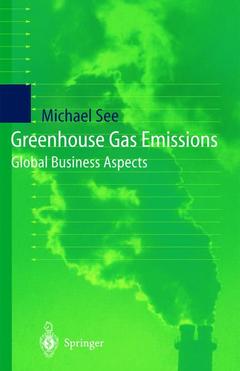Description
Greenhouse Gas Emissions, Softcover reprint of the original 1st ed. 2001
Global Business Aspects
Author: See Michael
Language: French
Subjects for Greenhouse Gas Emissions:
Greenhouse Gas Emissions
Publication date: 10-2012
375 p. · 15.5x23.5 cm · Paperback
Publication date: 10-2012
375 p. · 15.5x23.5 cm · Paperback
Approximative price 129.73 €
Subject to availability at the publisher.
Add to cart
Greenhouse gas emissions, global business aspects
Publication date: 06-2001
374 p. · 16x24 cm · Hardback
Publication date: 06-2001
374 p. · 16x24 cm · Hardback
Description
/li>Contents
/li>Comment
/li>
The world is getting hotter as it experiences the extremes of global climate change. In 1999, catastrophic storms hit Honduras, China and East India, bringing severe devas tation to lives and national economies. EI Nino swept across the Pacific in early 2000, inflicting the worst floods on Mozambique and neighbouring countries. Industrialised nations are not immune to global warming - cases of encephalitis, a disease trans mitted by mosquitoes, were reported in the State of New York. In Antarctica, an iceberg seven times the size of Manhattan island broke loose and floated towards Cape Horn. The melting of Arctic glaciers also continues - huge volumes of fresh-water will disrupt the warm conveyor-belt from Central America to Europe. The net effect of convergent glacial drifts from the polar regions to the equator is expected to inten sify cloud formation in the tropics - hence exacerbating global warming. As the destructive forces of nature intensify, so does the rhetoric from environmental organ isations - as evidenced by the disruption of the last World Trade Organisation con ference in Seattle. It is now up to civilisation to challenge climate change. It can achieve this by command and control as well as flexible mechanisms at home and abroad, before the process of global warming becomes totally irreversible.
1 Introduction.- 2 Global Warming.- 3 The Kyoto Protocol’s Flexible Mechanisms.- 4 Institutional Issues.- 5 Global Emissions of Carbon Dioxide.- 6 Clean Development Mechanism Project Prospects.- 7 Project Parameters and Equitable Treatment.- 8 CO2 Reduction Technologies and Financial Analysis.- 9 Emissions Trading.- Conclusions.- Appendices.- A1 Contact Addresses of Environmental Authorities/Relevant Government Authorities in Developing Countries.- A2 United Nations and Multilateral Environmental Organisations Concerned with Environmental Policies and Financing of Projects.- A3 Emissions Measurement and Monitoring.- A3.1 Technical Methods (Table A3.1).- A3.2 Maintaining Sustainability in Kyoto Protocol Projects.- A3.3 World Bank Guidelines on Environmental Standards — Major Atmospheric, Land and Water Pollutants from Industries and Domestic Sources (Table A3.2).- A4 The Green 500 Project — A National Green Index to Rank Firms, Case Study: United Kingdom, Case Example 1, Case Example 2 (Tables A4.1, A4.2).- A5 Carbon Accounting and Carbon Taxes.- A5.1 Accounting for Carbon Assets.- A5.2 Effect of Taxation on Carbon Dioxide Emissions.- A6 National Pilot Schemes for Emissions Permits Trading Outside Annex I countries.- A6.1 National Permits Trading Scheme for India and China: Bilateral Cooperation Between the World’s Two Most Populous Countries.- A6.2 Model Questionnaire to Enterprises in Developing Countries.- A7.1 Annuitised and Levelised Costs of Carbon Abatement.- A7.2 Pricing Credits or Permits: Calculating “Overnight” and “Discounted” Cost.- A7.5 Economics of Energy Conversion — Coal to Natural Gas for Power Stations.- A8 Cost Data — Indicative Costs of Key Equipment for Thermal Power Projects.- A9.1 The Clean Development Mechanism.- A9.2 Role ofthe Conference of the Parties (Governments).- A9.3 The Role of the Private Sector and Trading Exchanges.- A9.4 Kyoto Protocol and Non-Kyoto Protocol Risks.- A9.5 Case for Private Sector Financing of CDM Projects.- A9.6 Issues Regarding “Tradability” of Emissions Credits Earned by Non-Annex I Firms.- A9.7 Case of Governments Which Have Not, or May Not, Sign Up to the Kyoto Protocol.- A9.8 Countries Listed in Annex I to the Convention Compared to Countries listed in Annex B to the Protocol.- A9.9 Definition of Small and Medium-Size Enterprises, and Large Companies.- A9.10 Project Selection Criteria for the CDM: Industries and Country Targets.- A9.11 Reference Datum for Measuring Emissions Reductions for CDM: Emissions Additionally.- A9.12 How Annex I Countries Can Move Ahead with the CDM.- A9.13 A Global Private Equity Fund — The World CDM Green Fund.- A10 Islands-at-Risk — Contingency Plans for Evacuation and Resettlement (Tables A10.1, A10.2, A10.3 and A10.4).- Annexes Annex 1 Annex A of the Kyoto Protocol: Targeted Greenhouse Gases and Sources.- Annex 2 Annex B of the Kyoto Protocol: Countries and QELRCs (commitments).- Annex 4 List of Countries Signing and Ratifying the Kyoto Protocol, at end 1999.- Units, Definitions and Conversion Factors.- Figures Index.- Country, Place Index.- Persons Index.
Very new proposals on the practical implementation and financing of remedial strategies for developing countries based on the Clean Development Mechanism of the Kyoto Protocol. Includes supplementary material: sn.pub/extras
© 2024 LAVOISIER S.A.S.



